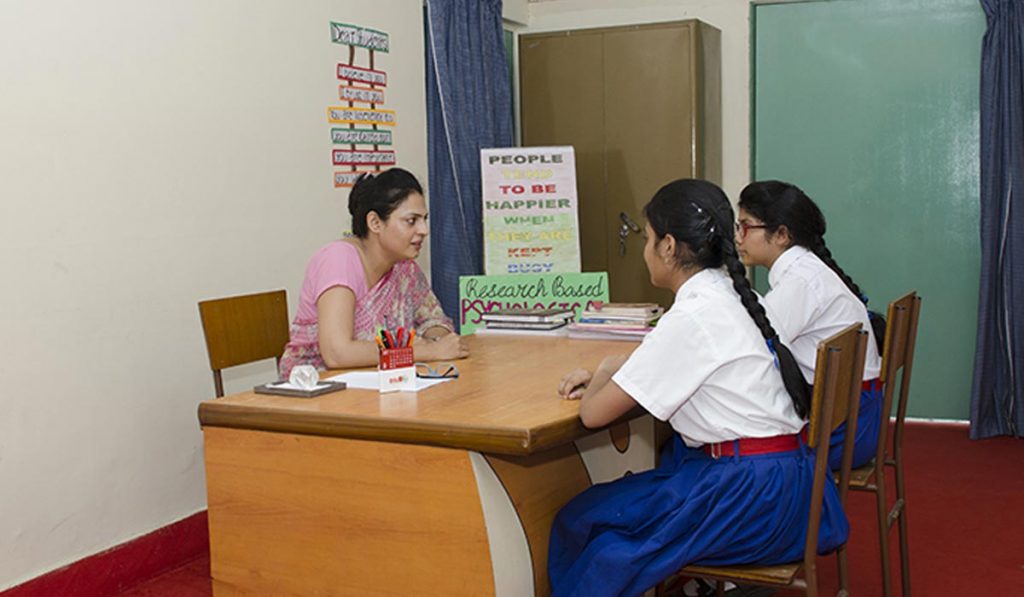
The research showed that a single, lay counsellor-delivered, classroom sensitisation session increased psychological help-seeking for common mental health problems among secondary school pupils from urban, low-income communities in India.
Authors
Rachana Parikh, Department of Clinical, Neuro and Developmental Psychology, Faculty of Behavioural and Movement Sciences, Vrije Universiteit Amsterdam, Amsterdam, The Netherlands; Sangath, Delhi; PATH, Delhi, India.
Adriaan Hoogendoorn, GGZ inGeest, Amsterdam, The Netherlands; Amsterdam UMC, Vrije Universiteit, Psychiatry, Amsterdam Public Health Research Institute, Amsterdam, The Netherlands.
Daniel Michelson, School of Psychology, University of Sussex, Brighton, UK.
Jeroen Ruwaard, GGZ inGeest, Amsterdam, The Netherlands; Amsterdam UMC, Vrije Universiteit, Psychiatry, Amsterdam Public Health Research Institute, Amsterdam, The Netherlands.
Rhea Sharma, Sangath, Delhi, India.
Bhargav Bhat, Sangath, Porvorim, Goa, India.
Kanika Malik, Sangath, New Delhi; Jindal School of Psychology and Counselling, O.P. Jindal Global University, Sonepat, Haryana, India.
Rooplata Sahu, Sangath, Delhi, India.
Pim Cuijpers, Department of Clinical, Neuro and Developmental Psychology, Amsterdam Public Health Research Institute, Amsterdam, The Netherlands.
Vikram Patel, Sangath, Porvorim, Goa, India; Department of Global Health and Social Medicine, Harvard Medical School, Boston, Massachusetts, USA; Department of Global Health and Population, Harvard T.H. Chan School of Public Health, Boston, Massachusetts, USA.
Summary
The researchers evaluated a classroom-based sensitisation intervention that was designed to reduce demand-side barriers affecting referrals to a school counselling programme. The sensitisation intervention was offered in the context of a host trial evaluating a low-intensity problem-solving treatment for common adolescent mental health problems.
The researchers conducted a stepped-wedge, cluster randomised controlled trial with 70 classes in 6 secondary schools serving low-income communities in New Delhi, India.The classes were randomised to receive a classroom sensitisation session involving a brief video presentation and moderated group discussion, delivered by a lay counsellor over one class period (intervention condition, IC), in two steps of 4 weeks each.
The control condition (CC) was whole-school sensitisation (teacher-meetings and whole-school activities such as poster displays). The primary outcome was the proportion of students referred into the host trial. Secondary outcomes were the proportion of students who met mental health caseness criteria and the proportion of self-referred adolescents.
Between 20 August 2018 and 9 December 2018, 835 students (23.3% of all students) were referred into the host trial. The referred sample included 591 boys (70.8%), and had a mean age of 15.8 years, SD=0.06; 194 students (31.8% of 610 with complete data) met mental health caseness criteria.
The proportion of students referred in each trial conditionwas significantly higher in the IC (IC=21.7%, CC=1.5%, OR=111.36, 95% CI 35.56 to 348.77, p<0.001). The proportion of self-referred participants was also higher in the IC (IC=98.1%, CC=89.1%, Pearson χ2 (1)=16.92, p<0.001). Although the proportion of referred students meeting caseness criteria was similar in both conditions (IC=32.0% vs CC=28.1%), the proportion weighted for the total student population was substantially higher in the IC (IC=5.2%, CC=0.3%, OR=52.39, 95% CI 12.49 to 219.66,p<0.001).
A single, lay counsellor-delivered, classroom sensitisation session increased psychological help-seeking for common mental health problems among secondary school pupils from urban, low-income communities in India.
Published in: BMJ Global Health
To read the full article, please click here


